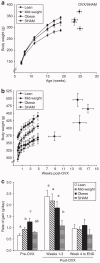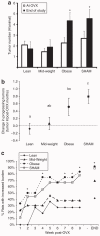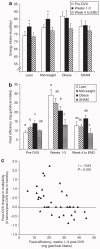A surprising link between the energetics of ovariectomy-induced weight gain and mammary tumor progression in obese rats
- PMID: 19798068
- PMCID: PMC4973619
- DOI: 10.1038/oby.2009.307
A surprising link between the energetics of ovariectomy-induced weight gain and mammary tumor progression in obese rats
Abstract
Obesity increases the risk for postmenopausal breast cancer. We have modeled this metabolic context using female Wistar rats that differ in their polygenic predisposition for obesity under conditions of high-fat feeding and limited physical activity. At 52 days of age, rats were injected with 1-methyl-1-nitrosourea (MNU, 50 mg/kg) and placed in an obesogenic environment. At 19 weeks of age, the rats were separated into lean, mid-weight, and obese rats, based upon their weight gained during this time. The rats were ovariectomized (OVX) at approximately 24 weeks of age and the change in tumor multiplicity and burden, weight gain, energy intake, tumor estrogen receptor (ER) status, and humoral metabolite and cytokine profiles were examined. The survival and growth of tumors increased in obese rats in response to OVX. OVX induced a high rate of weight gain during post-OVX weeks 1-3, compared to SHAM-operated controls. During this time, feed efficiency (mg gain/kcal intake) was lower in obese rats, and this reduced storage efficiency of ingested fuels predicted the OVX-induced changes in tumor multiplicity (r = -0.64, P < 0.001) and burden (r = -0.57, P < 0.001). Tumors from obese rats contained more cells that expressed ERalpha, and post-OVX plasma from rats with the lowest feed efficiency had lower interleukin (IL)-2 and IL-4 levels. Our observations suggest a novel link between obesity and mammary tumor promotion that involves impaired fuel metabolism during OVX-induced weight gain. The metabolically inflexible state of obesity and its inability to appropriately respond to the OVX-induced energy imbalance provides a plausible explanation for this relationship and the emergence of obesity's impact on breast cancer risk after menopause.
Figures




Similar articles
-
Impact of obesity on development and progression of mammary tumors in preclinical models of breast cancer.J Mammary Gland Biol Neoplasia. 2013 Dec;18(3-4):333-43. doi: 10.1007/s10911-013-9300-x. J Mammary Gland Biol Neoplasia. 2013. PMID: 24122258 Free PMC article. Review.
-
Obesity and overfeeding affecting both tumor and systemic metabolism activates the progesterone receptor to contribute to postmenopausal breast cancer.Cancer Res. 2012 Dec 15;72(24):6490-501. doi: 10.1158/0008-5472.CAN-12-1653. Epub 2012 Dec 7. Cancer Res. 2012. PMID: 23222299 Free PMC article.
-
The Androgen Receptor Supports Tumor Progression After the Loss of Ovarian Function in a Preclinical Model of Obesity and Breast Cancer.Horm Cancer. 2017 Dec;8(5-6):269-285. doi: 10.1007/s12672-017-0302-9. Epub 2017 Jul 24. Horm Cancer. 2017. PMID: 28741260 Free PMC article.
-
Prior weight loss exacerbates the biological drive to gain weight after the loss of ovarian function.Physiol Rep. 2017 May;5(10):e13272. doi: 10.14814/phy2.13272. Physiol Rep. 2017. PMID: 28533263 Free PMC article.
-
Perimenopausal weight gain and progression of breast cancer precursors.Cancer Detect Prev. 1999;23(1):31-6. doi: 10.1046/j.1525-1500.1999.00063.x. Cancer Detect Prev. 1999. PMID: 9892988 Review.
Cited by
-
Effect of the estrous cycle and surgical ovariectomy on energy balance, fuel utilization, and physical activity in lean and obese female rats.Am J Physiol Regul Integr Comp Physiol. 2010 Dec;299(6):R1634-42. doi: 10.1152/ajpregu.00219.2010. Epub 2010 Oct 6. Am J Physiol Regul Integr Comp Physiol. 2010. PMID: 20926768 Free PMC article.
-
Metformin Accumulation Correlates with Organic Cation Transporter 2 Protein Expression and Predicts Mammary Tumor Regression In Vivo.Cancer Prev Res (Phila). 2017 Mar;10(3):198-207. doi: 10.1158/1940-6207.CAPR-16-0211-T. Epub 2017 Feb 2. Cancer Prev Res (Phila). 2017. PMID: 28154203 Free PMC article.
-
The role of ovarian sex steroids in metabolic homeostasis, obesity, and postmenopausal breast cancer: molecular mechanisms and therapeutic implications.Biomed Res Int. 2015;2015:140196. doi: 10.1155/2015/140196. Epub 2015 Mar 19. Biomed Res Int. 2015. PMID: 25866757 Free PMC article. Review.
-
Designing Relevant Preclinical Rodent Models for Studying Links Between Nutrition, Obesity, Metabolism, and Cancer.Annu Rev Nutr. 2021 Oct 11;41:253-282. doi: 10.1146/annurev-nutr-120420-032437. Epub 2021 Aug 6. Annu Rev Nutr. 2021. PMID: 34357792 Free PMC article. Review.
-
Impact of obesity on development and progression of mammary tumors in preclinical models of breast cancer.J Mammary Gland Biol Neoplasia. 2013 Dec;18(3-4):333-43. doi: 10.1007/s10911-013-9300-x. J Mammary Gland Biol Neoplasia. 2013. PMID: 24122258 Free PMC article. Review.
References
-
- Osler M. Obesity and cancer. A review of epidemiological studies on the relationship of obesity to cancer of the colon, rectum, prostate, breast, ovaries, and endometrium. Dan Med Bull. 1987;34:267–274. - PubMed
-
- Barnett JB. The relationship between obesity and breast cancer risk and mortality. Nutr Rev. 2003;61:73–76. - PubMed
-
- Calle EE, Kaaks R. Overweight, obesity and cancer: epidemiological evidence and proposed mechanisms. Nat Rev Cancer. 2004;4:579–591. - PubMed
-
- Radimer KL, Ballard-Barbash R, Miller JS, et al. Weight change and the risk of late-onset breast cancer in the original Framingham cohort. Nutr Cancer. 2004;49:7–13. - PubMed
Publication types
MeSH terms
Substances
Grants and funding
LinkOut - more resources
Full Text Sources
Medical

